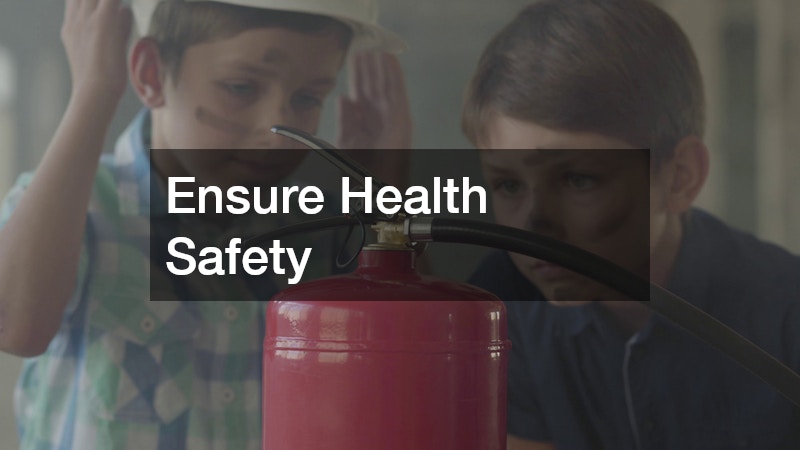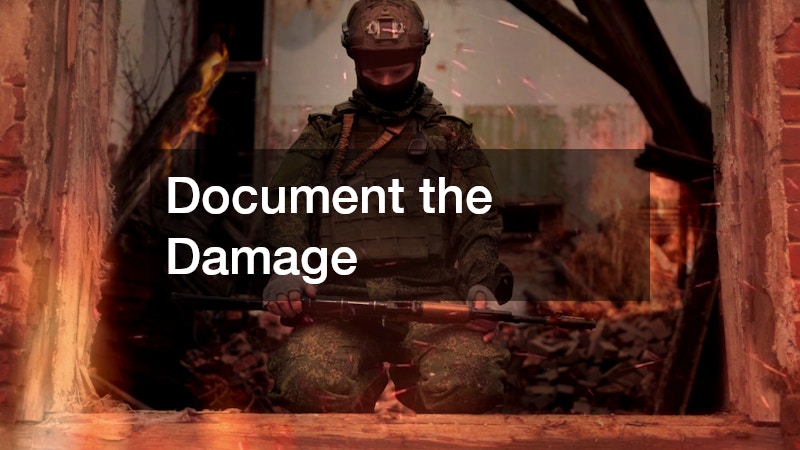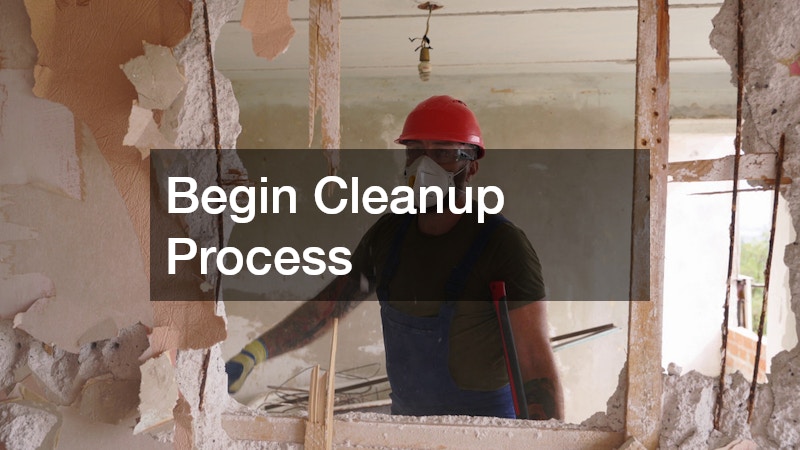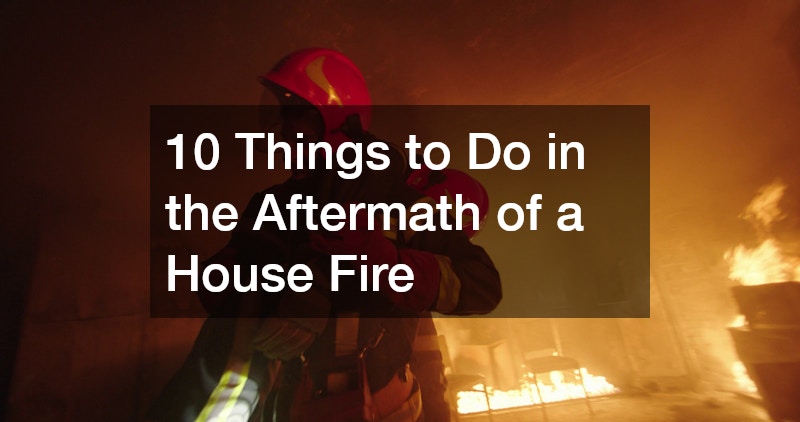A house fire is one of the most traumatic events a homeowner can experience. In mere minutes, flames can consume a space that took years to build and fill with memories. The physical damage is devastating, but the emotional and logistical challenges that follow can feel just as overwhelming. While no one ever anticipates being in this situation, understanding the critical steps to take after such an incident can help ease the burden and provide a clearer path toward recovery.
The aftermath of a house fire isn’t just about cleaning up—it involves making a series of important decisions quickly and efficiently. From safeguarding your health and securing your property to managing insurance claims and salvaging what you can, every step plays a role in restoring stability to your life. The chaos can be paralyzing, especially when you’re unsure where to start or whom to trust. That’s why having a plan in place—or at least knowing what actions to prioritize—can make a significant difference during this difficult time.
This guide covers the 10 most essential things to do after a house fire, carefully selected steps that address your safety, health, belongings, and overall recovery. Whether you’re facing minor smoke damage or complete structural loss, this blog will guide you step-by-step so you don’t have to navigate this crisis blindly. By understanding and organizing the next steps, you can regain a sense of control and take the first solid strides toward rebuilding. Let’s take a closer look at the 10 most important things to do in the aftermath of a home blaze.
1. Call Emergency Help
Immediately following a fire disaster, your priority should always be health and safety. Even if the flames are out and you believe everyone is accounted for, calling emergency services ensures any hidden risks are professionally assessed. Inhaling smoke or suffering burns—even minor ones—can have serious consequences, and a delay in medical attention can lead to complications. Emergency responders can also determine whether the structure is safe to enter, helping prevent additional injuries.
Once you and your family are safe, a visit to a physician is critical, even if no one appears seriously hurt. The effects of smoke inhalation aren’t always visible right away and can include respiratory issues or other health complications. Children, elderly individuals, and those with pre-existing conditions are especially vulnerable and should be seen as soon as possible. Additionally, if anyone experiences signs of shock or trauma, they may require immediate evaluation.
The stress of experiencing a house fire can also manifest in physical symptoms days later. Scheduling follow-ups with your physician ensures continued monitoring and care. Not only does this protect your health, but proper documentation may also be helpful for insurance or legal matters down the line. Putting health first sets the tone for your recovery process.
2. Ensure Health Safety

Health hazards don’t end with the flames. The site may be contaminated with soot, ash, chemicals, or even hazardous building materials like asbestos. Before reentering the premises, you need to make sure it’s safe for breathing and walking around. It’s tempting to start sifting through belongings, but exposure to unseen dangers can pose long-term health risks.
While fire extinguishers are typically thought of as tools used before major fires, they still play a post-fire role. Firefighters may not extinguish every hot spot, and small flare-ups can occur unexpectedly. Keeping a few fire extinguishers on hand when returning to the home, even briefly, can offer peace of mind. It’s a precaution that ensures any remaining embers or rekindled flames don’t lead to further disaster.
Health safety also means wearing the proper gear if you must reenter the property. Use masks, gloves, and protective clothing to reduce exposure to contaminants. If you’re unsure whether it’s safe, wait for professionals to clear the site. Fire residues can be toxic, and thorough assessments and protective measures are necessary for your long-term well-being.
3. Secure the Property
One of the first things to consider after the fire is securing your home against further damage or intrusion. Even if the fire has rendered it uninhabitable, it still needs to be protected. Open windows, broken doors, and exposed entry points leave it vulnerable to weather, animals, and even theft. A house fire already results in major losses—don’t allow additional ones to happen due to a lack of security.
Interestingly, even after a fire, the importance of a functioning fire alarm system isn’t diminished. If parts of the house are still operational or under repair, a working fire alarm can provide a vital layer of protection in case hot spots or electrical faults reignite. Some systems may need to be replaced after fire damage, so having an expert assess your alarm system is wise.
Boarding up doors, sealing windows with tarps, and placing signage warning trespassers can help secure your property. You may also consider contacting local law enforcement to request extra patrols around the property during recovery. Keeping your home secured ensures your belongings and structural elements are safe as you begin the rebuilding process.
4. Document the Damage

Thoroughly documenting everything after a blaze is essential for insurance, repair estimates, and potential legal proceedings. This includes taking photos and videos of every affected area—interior, exterior, contents, and even undamaged parts. You may not want to relive the destruction through pictures, but the documentation process is a foundational part of financial recovery.
Fire damage can be complex, affecting structures in ways that aren’t immediately visible. Charring, smoke residue, and water-soaked materials all count in the assessment. Make a list of damaged items and try to find receipts or proof of ownership. The more detailed your records, the smoother the claims process will go, and the more likely you are to receive full compensation.
Proper documentation not only helps with your immediate insurance claim but also with your long-term recovery plan. Contractors and inspectors will need to reference these materials to plan repairs. Take the time to label and organize your evidence—this step can save time, money, and frustration as you work to restore your home.
5. Arrange Temporary Stay
After a house fire, it’s likely your home will be uninhabitable for some time. One of the first practical steps is finding a safe, comfortable place to stay. Whether it’s with friends, family, or a hotel covered by insurance, securing temporary shelter helps restore stability. You’ll need space not just for rest but also for coordinating next steps and storing essentials.
In the process of relocating, you’ll also need a place to store any items salvaged from the home. A secure storage facility provides a safe environment for your belongings while you sort through what’s worth keeping and what can be repaired. Items exposed to fire or smoke may need professional cleaning, but immediate shelter from the elements is a top priority.
A temporary stay isn’t just about a roof over your head—it’s a critical step in regaining normalcy after your home burns. It allows your family to decompress, process the event, and make decisions without added stress. Having access to a storage facility and a reliable temporary living arrangement can significantly ease the transition during this difficult time.
6. Contact Insurance Team

Your insurance policy is one of the most important resources you have. However, understanding its complexities can be daunting. That’s where calling your provider and hiring a professional advocate, like a fire public adjuster, can be incredibly beneficial. These specialists represent your interests, not the insurance company, and ensure your claim is properly handled.
A fire public adjuster works on your behalf to evaluate the damage, file paperwork, and negotiate with insurers. They understand the nuances of insurance language and can often secure higher payouts than homeowners might receive on their own. This is particularly important when it comes to replacing personal property, rebuilding structures, and securing temporary living expenses.
Don’t wait too long to get a public adjuster involved. The sooner they’re on board, the better they can support you. They will assess the full scope of the damage and work with contractors, inspectors, and legal representatives as needed. Navigating insurance post-fire is tough, but a knowledgeable adjuster can make the process far more manageable and less stressful.
7. Request Property Review
Even if the flames are extinguished, the structural integrity of your home could still be compromised. Scheduling a fire inspection is crucial before any repairs or restoration efforts begin. This official review evaluates the extent of the damage, identifies safety hazards, and helps determine whether the home can be salvaged or must be partially or fully rebuilt.
A fire inspection involves much more than a visual check. Inspectors look for issues like weakened beams, compromised electrical systems, and damaged plumbing. This assessment also ensures compliance with local building codes and regulations. A proper inspection protects your family from future risks that might arise from hidden structural flaws.
The fire inspection forms the backbone of your recovery timeline. It informs insurance claims, contractor estimates, and city permits. Skipping this step—or rushing it—can lead to complications down the road. Make sure you work with certified professionals and keep a copy of the inspection report for your records and future planning.
8. Begin Cleanup Process

Once the site is deemed safe, cleanup can begin. However, cleaning after a house fire isn’t a matter of wiping down surfaces—it’s a specialized task that often requires the help of fire damage restoration professionals. These experts have the tools and experience to safely remove soot, ash, and debris while minimizing exposure to toxins.
Fire damage restoration teams don’t just clean—they sanitize, deodorize, and treat the property to prevent further deterioration. Smoke and soot can permeate walls, furniture, and HVAC systems. Left untreated, this residue can lead to permanent staining and long-term air quality issues. Professional intervention ensures these issues are properly addressed.
Starting the cleanup process marks the shift from survival mode to recovery mode. It’s both symbolic and practical—a sign that the path to rebuilding has officially begun. With the help of a trusted fire damage restoration crew, you can be confident that your home is being cared for safely and thoroughly.
9. Salvage What You Can
Fires often lead to water damage from firefighting efforts, which can be just as destructive as the flames themselves. Items soaked in water can grow mold quickly, and structural materials like drywall or flooring may warp and rot. That’s why hiring a water damage contractor is a smart and necessary step.
A water damage contractor specializes in extracting standing water, drying the environment, and preventing mold. They use industrial-grade equipment to remove moisture and restore affected areas. Their expertise ensures that damage doesn’t spread silently over time, creating bigger issues months later.
Even though a fire may seem like the main disaster, the water used to extinguish it can create a second emergency. Working with professionals to recover items and repair damage quickly helps save money, time, and emotional stress. Salvaging what you can with expert help makes a big difference in your recovery.
10. Plan for the Rebuild
Rebuilding after a house fire can feel like an overwhelming endeavor, but it’s also a chance for a fresh start. Before construction begins, you’ll need to move whatever belongings are salvageable to safety. Working with a professional mover helps make this transition smooth and organized.
Movers experienced in post-disaster scenarios understand how to handle fragile or partially damaged items. They’ll help pack and transport what you can save, clearing the way for contractors and inspectors to begin their work. This step is essential in preparing the home for restoration or reconstruction.
Rebuilding is more than just repairing walls—it’s about restoring your life. With the right mover, your possessions are protected during the transition. Taking this step ensures your focus stays on recovery, not on logistics. Planning and working with trustworthy professionals sets you on the path to rebuilding after a fire.
The days following a fire are filled with confusion, heartbreak, and an overwhelming list of responsibilities. Knowing what to do next can offer a sense of control in a time when everything feels uncertain. This guide has walked you through the most important steps—from protecting your health and documenting the scene, to working with insurance professionals and preparing for restoration. Each action is designed to bring clarity and direction during a chaotic time.
Whether it’s securing emergency medical care, retrieving belongings with the help of a mover, or evaluating the structural safety of your home, each step is crucial in turning the page from crisis to recovery. Working with professionals like a fire public adjuster, fire damage restoration experts, and a water damage contractor ensures you’re not alone in the process. These people bring not just skill, but stability when it’s needed most.
Recovery from a fire at home takes time, effort, and emotional resilience. But by tackling each of these ten steps with purpose, you can protect your family, finances, and future. The goal isn’t just to repair a house—it’s to rebuild a home. Every small action you take adds to your momentum, giving you the strength to move forward.
Remember, you’re not expected to handle everything at once or entirely on your own. Ask for help when you need it, lean on experts, and take care of your physical and emotional well-being. A house fire can shake the very foundation of your life, but with the right steps, support, and mindset, rebuilding is not only possible—it’s powerful.

